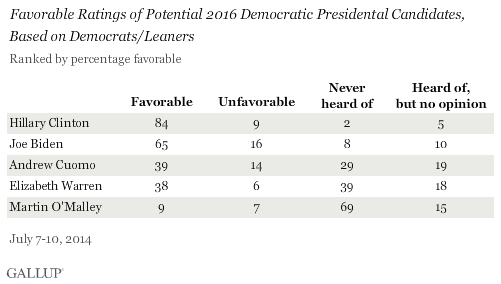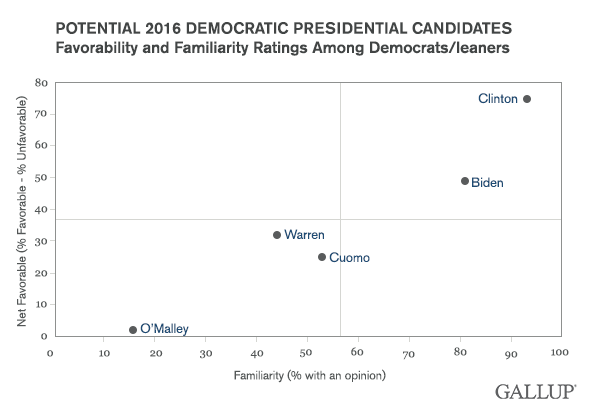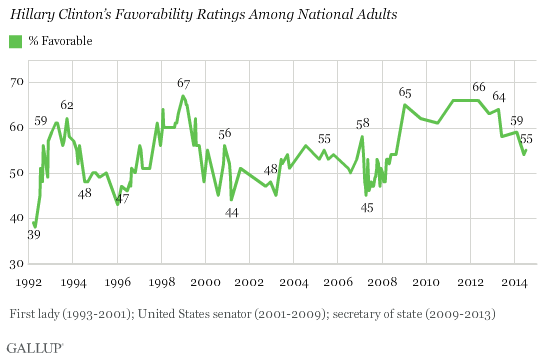WASHINGTON, D.C. -- Out of a field of five potential 2016 presidential candidates, only Hillary Clinton and Joe Biden are viewed favorably by a majority of Democrats and Democratic-leaning independents. The other possible contenders are less well-known to Democrats. In fact, nearly seven in 10 Democrats say they have never heard of Maryland Gov. Martin O'Malley.

The results are based on a July 7-10 Gallup poll. Gallup previously reported on the current public images of 16 different potential 2016 presidential candidates from both parties, and on how Republicans rate the field of the major GOP contenders.
While speculation about the 2016 campaign may be premature, especially in advance of the November midterm elections, Democrats' have clear-cut opinions of two candidates: Clinton and Biden. Ninety-three percent of Democrats have an opinion of Clinton, who has been on the national stage for 22 years as secretary of state, as a U.S. senator from New York, and first lady. As for the vice president, 81% of Democrats have an opinion of Biden, who previously served as a U.S. senator from Delaware for 36 years and ran unsuccessfully for president in 1988 and 2008.
Massachusetts Sen. Elizabeth Warren, New York Gov. Andrew Cuomo, and O'Malley do not have the long political careers that Biden and Clinton have, and at this point, they are struggling to attain a high profile on the national stage.
- Andrew Cuomo, son of three-term New York Gov. Mario Cuomo, is running for his second term as governor this year after previously being the state's attorney general and Secretary of Housing and Urban Development under President Bill Clinton. Despite that long career and being in a prominent family that includes his brother Chris Cuomo, a CNN news personality, nearly half of Democrats (48%) have never heard of or don't have an opinion of the governor.
- Elizabeth Warren, a first-term senator, was a former Harvard Law professor and served in the Obama administration as a special adviser to the Consumer Financial Protection Bureau. She has been campaigning nationally for Democratic candidates, some of whom are running in traditionally strong Republican states, such as West Virginia and Kentucky. Warren has said that she is touting her populist message to ensure the Democratic agenda succeeds in the next Congress. However, Warren is still far from a household name among Democrats: 57% of Democrats nationally have never heard of or don't have an opinion of the senator.
- Martin O'Malley is finishing his second term as governor of Maryland, having been elected in 2006 after eight years as the mayor of Baltimore. While he counts as a success signing same-sex marriage into state law in 2012, O'Malley has not gained much traction with the American public. The vast majority of Democrats (84%) have neither heard of O'Malley or don't have an opinion of him.
Clinton and Biden enjoy high familiarity and high favorability ratings with Democrats and Democratic-leaning independents. By subtracting her unfavorable rating from her favorable rating, Clinton has a net favorable rating of +75, far higher than any other potential presidential candidate, including Republican candidates. As would be expected, Democrats rate all of these Democratic politicians more positively than negatively, with Biden at +49 net favorable, Warren at +32, Cuomo at +25, and the little-known O'Malley at +2.

Clinton, Despite Potential Missteps, Maintains Favorability Nationwide
Clinton, who has been on a tour promoting her memoir of her term as secretary of state, Hard Choices, has maintained her high favorability rating on a national scale as well, with 55% of all Americans having a positive view of her and 36% an unfavorable view. This is despite potential missteps on the book tour where she referred to herself and her husband as "dead broke" when they left the White House in 2001. As a result, Clinton has been under increased scrutiny over her speaking fees, including the revelation that the State University of New York at Buffalo paid her $275,000 to speak there.
Clinton's favorable rating among Americans has been as high as 67% in 1998, at the time of her husband's impeachment. Her favorable ratings were in that same territory during her years as secretary of state, but have declined since she left that post and speculation began about her 2016 presidential intentions. Several times throughout the last 20+ years, Clinton's favorable ratings have dipped below 50%. This includes in 1994 when her attempt to institute national healthcare failed, throughout much of the 1996 election year prior to the Democratic convention, in 2001 after the Clintons' messy White House departure, and at various times in 2007 and 2008 during her quest for the party's presidential nomination.

Bottom Line
Hillary Clinton dominates the Democratic field for the 2016 presidential nomination. Even though she has not announced a second run for the presidency and may decide not to run again, she is clearly better known and better perceived among Democrats than any other potential challenger for the party's nomination. That may not be good news for Biden, who in most years would have the inside track to the nomination as a sitting vice president. The last vice president who wanted to run for his party's nomination but failed was Alben Barkley, President Harry Truman's vice president in 1952. Barkley was dismissed as "too old" to run at age 74, which would be the same age Biden would be if he were inaugurated as president.
Warren, Cuomo, and O'Malley have work to do to raise their familiarity and favorability ratings among Americans - let alone among their own party's base. Overshadowed by Clinton at this point, it could be difficult for these Democrats to boost their profiles enough to mount a serious challenge to Clinton should the former secretary decide to run. O'Malley would have a particularly uphill climb in raising awareness as he prepares to exit his platform as governor; at this point, fewer than two in 10 Democrats know enough about him to have an opinion.
Survey Methods
Results for this Gallup poll are based on telephone interviews conducted July 7-10, 2014, with a random sample of 1,013 adults, aged 18 and older, living in all 50 U.S. states and the District of Columbia.
For results based on the total sample of national adults, the margin of sampling error is ±4 percentage points at the 95% confidence level.
Interviews are conducted with respondents on landline telephones and cellular phones, with interviews conducted in Spanish for respondents who are primarily Spanish-speaking. Each sample of national adults includes a minimum quota of 50% cellphone respondents and 50% landline respondents, with additional minimum quotas by time zone within region. Landline and cellular telephone numbers are selected using random-digit-dial methods. Landline respondents are chosen at random within each household on the basis of which member had the most recent birthday.
Samples are weighted to correct for unequal selection probability, nonresponse, and double coverage of landline and cell users in the two sampling frames. They are also weighted to match the national demographics of gender, age, race, Hispanic ethnicity, education, region, population density, and phone status (cellphone only/landline only/both, and cellphone mostly). Demographic weighting targets are based on the most recent Current Population Survey figures for the aged 18 and older U.S. population. Phone status targets are based on the most recent National Health Interview Survey. Population density targets are based on the most recent U.S. census. All reported margins of sampling error include the computed design effects for weighting.
In addition to sampling error, question wording and practical difficulties in conducting surveys can introduce error or bias into the findings of public opinion polls.
View survey methods, complete question responses, and trends.
For more details on Gallup's polling methodology, visit www.gallup.com.
